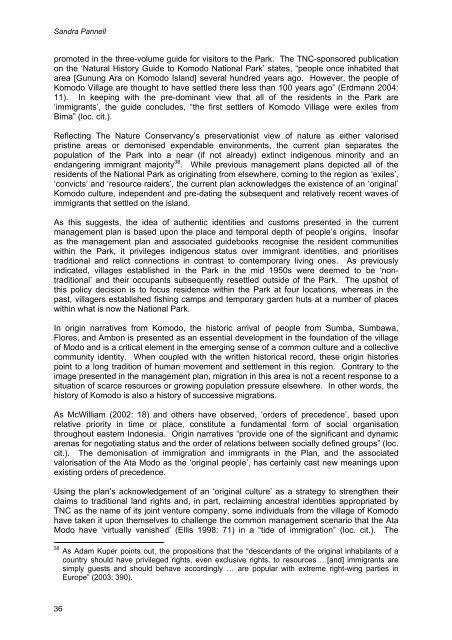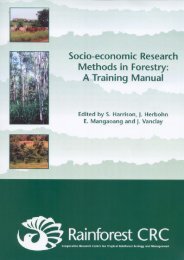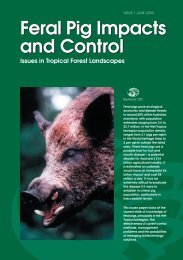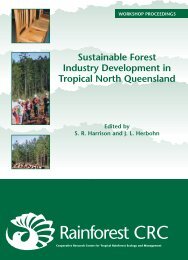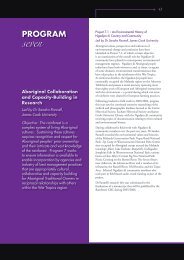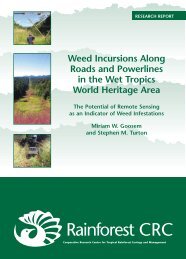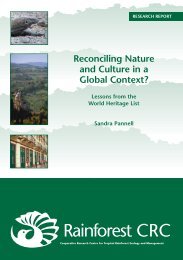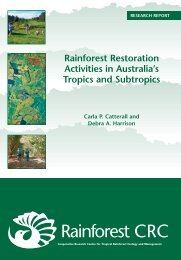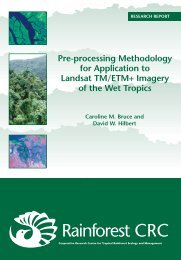Reconciling Nature and Culture in a Global Context? - Rainforest ...
Reconciling Nature and Culture in a Global Context? - Rainforest ...
Reconciling Nature and Culture in a Global Context? - Rainforest ...
You also want an ePaper? Increase the reach of your titles
YUMPU automatically turns print PDFs into web optimized ePapers that Google loves.
S<strong>and</strong>ra Pannellpromoted <strong>in</strong> the three-volume guide for visitors to the Park. The TNC-sponsored publicationon the ‘Natural History Guide to Komodo National Park’ states, “people once <strong>in</strong>habited thatarea [Gunung Ara on Komodo Isl<strong>and</strong>] several hundred years ago. However, the people ofKomodo Village are thought to have settled there less than 100 years ago” (Erdmann 2004:11). In keep<strong>in</strong>g with the pre-dom<strong>in</strong>ant view that all of the residents <strong>in</strong> the Park are‘immigrants’, the guide concludes, “the first settlers of Komodo Village were exiles fromBima” (loc. cit.).Reflect<strong>in</strong>g The <strong>Nature</strong> Conservancy’s preservationist view of nature as either valorisedprist<strong>in</strong>e areas or demonised expendable environments, the current plan separates thepopulation of the Park <strong>in</strong>to a near (if not already) ext<strong>in</strong>ct <strong>in</strong>digenous m<strong>in</strong>ority <strong>and</strong> anendanger<strong>in</strong>g immigrant majority 38 . While previous management plans depicted all of theresidents of the National Park as orig<strong>in</strong>at<strong>in</strong>g from elsewhere, com<strong>in</strong>g to the region as ‘exiles’,‘convicts’ <strong>and</strong> ‘resource raiders’, the current plan acknowledges the existence of an ‘orig<strong>in</strong>al’Komodo culture, <strong>in</strong>dependent <strong>and</strong> pre-dat<strong>in</strong>g the subsequent <strong>and</strong> relatively recent waves ofimmigrants that settled on the isl<strong>and</strong>.As this suggests, the idea of authentic identities <strong>and</strong> customs presented <strong>in</strong> the currentmanagement plan is based upon the place <strong>and</strong> temporal depth of people’s orig<strong>in</strong>s. Insofaras the management plan <strong>and</strong> associated guidebooks recognise the resident communitieswith<strong>in</strong> the Park, it privileges <strong>in</strong>digenous status over immigrant identities, <strong>and</strong> prioritisestraditional <strong>and</strong> relict connections <strong>in</strong> contrast to contemporary liv<strong>in</strong>g ones. As previously<strong>in</strong>dicated, villages established <strong>in</strong> the Park <strong>in</strong> the mid 1950s were deemed to be ‘nontraditional’<strong>and</strong> their occupants subsequently resettled outside of the Park. The upshot ofthis policy decision is to focus residence with<strong>in</strong> the Park at four locations, whereas <strong>in</strong> thepast, villagers established fish<strong>in</strong>g camps <strong>and</strong> temporary garden huts at a number of placeswith<strong>in</strong> what is now the National Park.In orig<strong>in</strong> narratives from Komodo, the historic arrival of people from Sumba, Sumbawa,Flores, <strong>and</strong> Ambon is presented as an essential development <strong>in</strong> the foundation of the villageof Modo <strong>and</strong> is a critical element <strong>in</strong> the emerg<strong>in</strong>g sense of a common culture <strong>and</strong> a collectivecommunity identity. When coupled with the written historical record, these orig<strong>in</strong> historiespo<strong>in</strong>t to a long tradition of human movement <strong>and</strong> settlement <strong>in</strong> this region. Contrary to theimage presented <strong>in</strong> the management plan, migration <strong>in</strong> this area is not a recent response to asituation of scarce resources or grow<strong>in</strong>g population pressure elsewhere. In other words, thehistory of Komodo is also a history of successive migrations.As McWilliam (2002: 18) <strong>and</strong> others have observed, ‘orders of precedence’, based uponrelative priority <strong>in</strong> time or place, constitute a fundamental form of social organisationthroughout eastern Indonesia. Orig<strong>in</strong> narratives “provide one of the significant <strong>and</strong> dynamicarenas for negotiat<strong>in</strong>g status <strong>and</strong> the order of relations between socially def<strong>in</strong>ed groups” (loc.cit.). The demonisation of immigration <strong>and</strong> immigrants <strong>in</strong> the Plan, <strong>and</strong> the associatedvalorisation of the Ata Modo as the ‘orig<strong>in</strong>al people’, has certa<strong>in</strong>ly cast new mean<strong>in</strong>gs uponexist<strong>in</strong>g orders of precedence.Us<strong>in</strong>g the plan’s acknowledgement of an ‘orig<strong>in</strong>al culture’ as a strategy to strengthen theirclaims to traditional l<strong>and</strong> rights <strong>and</strong>, <strong>in</strong> part, reclaim<strong>in</strong>g ancestral identities appropriated byTNC as the name of its jo<strong>in</strong>t venture company, some <strong>in</strong>dividuals from the village of Komodohave taken it upon themselves to challenge the common management scenario that the AtaModo have ‘virtually vanished’ (Ellis 1998: 71) <strong>in</strong> a “tide of immigration” (loc. cit.). The38 As Adam Kuper po<strong>in</strong>ts out, the propositions that the “descendants of the orig<strong>in</strong>al <strong>in</strong>habitants of acountry should have privileged rights, even exclusive rights, to resources …[<strong>and</strong>] immigrants aresimply guests <strong>and</strong> should behave accord<strong>in</strong>gly … are popular with extreme right-w<strong>in</strong>g parties <strong>in</strong>Europe” (2003: 390).36


